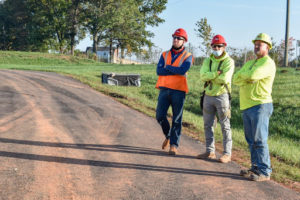If you have ever been involved in a commercial construction project, you likely understand the significance of both general contractors and subcontractors. While general contractors and subcontractors are both involved in construction, they have different roles and responsibilities to help ensure a project is of a high quality and completed safely and on time. To better understand their roles, it is important to look at each of their main responsibilities in a construction project.
General Contractors
When starting a construction project, it is common to hire a general contractor who is responsible for managing:
- subcontractor partners (including, selection, hiring, and oversight)
- project financials
- building materials
- schedule
- quality
- safety
- and more!
Depending on the delivery method, if the general contractor is also the Design Builder, they would also be responsible for designing the project or finding and partnering with an architect. To perform the necessary scope of work, some general contractors may subcontract out all work, while others may have in-house professionals who self-perform some aspect of construction, like drywall or painting for example.
Subcontractor Partners

One of the first steps a general contractor takes in pursuing a project involves contacting subcontractors and gathering bids for the scope of work. Once a general contractor has selected their subcontractor partners and wins a job, the general contractor is responsible for contracting the work, then supervising and managing those partners on site.
The general contractor ensures subcontractor partners perform the work safely, the way the architect intended, and at a high quality. General contractors are responsible for paying their subcontractor partners, just as the client/owner is responsible for paying the general contractor.
Building Materials
Sometimes materials are in a subcontractor’s contract, and they are responsible for purchasing and delivering the materials. However, the general contractor is still responsible for being aware of all the project’s building materials and ensuring that those materials are procured so work can begin on time.
If materials do not arrive on time or aren’t stored properly, they risk putting the schedule behind and potentially impacting the budget as well! Subcontractor partners cannot perform their work without the specified materials as defined by the architect in the project drawings and specification documents.

Quality
It is the general contractor’s responsibility to ensure that the completed project meets the design intent and is built to the standards of the client and architect partners. Many companies have quality control programs to ensure that their buildings are constructed at a high quality. Forrester Construction’s Quality Control Program is closely modeled after the US Army Corp of Engineers (USACE) Construction Quality Control program.
Forrester Construction’s quality control program includes:
- Preparatory Meeting – Drawings and contract reviews, subcontractor coordination, and safety plan development
- Initial Inspection – Mock-up reviews and initial inspections of work to establish acceptable standards
- Follow-up Inspection – Daily work-in-progress inspections for conformance and accepted standards
In addition, clients will walk a job at the end of a project and can point out punch list items for a general contractor to have fixed before they are given occupancy or completely turn the building over.
Safety

The general contractor is responsible for the safety of every single person on the job site. This includes the general contractor’s team members working on the job site, subcontractor partners performing manual labor, any visiting clients or architects, inspectors walking the site, and any community members who live around, or could be affected by, the construction.
There are many safety tips and ways to ensure the safety of the team and visitors, including mandating personal protective equipment (PPE), implementing safety training and incentives, and much more. Creating and maintaining a dedicated safety program is one of the best ways to stay on top of keeping the team safe.
The general contractor is also responsible for ensuring that construction work does not impact the safety of neighboring homes, buildings, traffic, or other community factors. Managing the safety of the surrounding community could include managing dirt and debris, deliveries, or installing construction fencing to ensure no one can wander on-site and potentially hurt themselves.
Schedule
Have you ever heard the phrase, “time is money”? It is especially true in the commercial construction industry!
Building projects like restaurants, healthcare facilities, and other organizations that depend on their building to operate and make money means that any delays to the construction schedule cost the client money. Creating a thoughtful schedule and managing subcontractors and materials properly to ensure that the project stays on that schedule is crucial to the owner utilizing their space as soon as possible.
Subcontractors

Most general contractors must work with subcontractors on some aspect of a construction project to complete the full scope of work the design requires. There are many types of subcontractors, including:
- Site Development
- Steel Erectors
- Mechanical
- Electrical
- Plumbing
- Carpentry
- Demolition and Abatement
- HVAC
- Landscaping
- Concrete
- Masonry
- And many more
The design and drawings determine the scope of work and show the general contractor what materials and labor are required to build the project. Different subcontractor partners specialize in performing specific trades, so many are needed to complete one project.
For example, when renovating a restaurant, associated trades or work could include drywall, electrical, plumbing, and more. The drywall subcontractor may be responsible for both drywall and framing, as they have the necessary skills and training, while a different subcontractor would paint the wall after it’s constructed.
Many areas of the building will require several specialties or required skills close together or overlapping. Things like MEP coordination can often avoid many unforeseen problems. All of this coordination across subcontractors is the responsibility of the general contractor.
Subcontractors will have little to no communication with the owner or architect, given that they report directly to and are paid by the general contractor. Depending on the project’s needs, a contractor may also elect to bring in several subcontractors with whom they have previously worked with and built a professional relationship.
Often if a project involves very technical work, a general contractor may try to secure a subcontractor partner who they know has the expertise to perform the required work at a high level, even if it may be more costly.
Conclusion
While there are many differences in the roles, responsibilities, and day-to-day tasks of general contractors and subcontractors, they must develop meaningful relationships and work closely together to deliver a successful project. Though different, both are vital to the completion of any construction project and to the overall commercial construction industry.
Are you a subcontractor looking to build impactful projects with us in the DMV? Visit the subcontractor page of our website to find out how to bid future projects with Forrester Construction.

